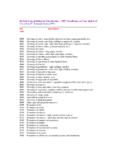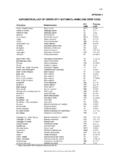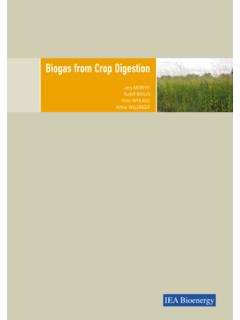Transcription of ORIGINAL ARTICLE THE BETALAINS CONTENT AND …
1 FARMACIA, 2016, Vol. 64, 2 198 ORIGINAL ARTICLE THE BETALAINS CONTENT AND ANTIOXIDANT capacity OF RED BEET (BETA VULGARIS L. SUBSP. VULGARIS) ROOT LAURA BUCUR*, GHEORGHE AR LUNG , VERGINICA SCHRODER Ovidius University Constanta, Faculty of Pharmacy, 1 University Street, Campus, Building B, Constanta, Romania *corresponding author: Manuscript received: December 2014 Abstract The aim of the study was to determine the BETALAINS CONTENT and the antioxidant capacity of Beta vulgaris L. subsp. vulgaris root, the red beet. The results obtained showed an almost double CONTENT in BETALAINS in fresh spring red beet ( mg/g ) in comparison to fresh autumn red beet ( mg/g ) and a high correlation, R2 = , with the 2,2-diphenyl-1-picrylhydrazyl (lDPPH) radical scavenging capacity , higher in the spring sample ( ) than autumn sample ( ).
2 Rezumat Obiectivul lucr rii a fost de a determina con inutul n betalaine i capacitatea antioxidant ale r d cinii de Beta vulgaris L. subsp. vulgaris, sfecla ro ie. Rezultatele ob inute arat un con inut n betalaine aproape dublu n sfecla de prim var (8,38 mg/g 1,14) n compara ie cu sfecla de toamn (4,62 mg/g 0,18) i o nalt corela ie, R2 = , cu capacitatea de captare de radicali liberi, folosind testul DPPH, mai mare la proba de prim var (63,56% 0,53) fa de cea de toamn (35,88% 3,22). Keywords: red beet, BETALAINS , antioxidant capacity , 2,2-diphenyl-1-picrylhydrazyl (lDPPH) Introduction BETALAINS are immonium derivatives of betalamic acid. They can be divided in two structural groups, the yellow betaxanthins and red-purple betacyanins. In Beta vulgaris L. subsp.
3 Vulgaris, betacyanin is named betanin and betaxanthin is named vulgaxanthin [5]. In the Plant List, the Beta vulgaris L. species has more than 40 synonyms, noted as varieties or subspecies [22]. In Romania, there are cultivated three varieties and a subspecies: subsp. vulgaris (red beet) [7], var. vulgaris (spinach beet), var. altissima Doll. (sugar beet) and var. crassa Alef. (fodder beet) [12]. The betalain pigments are important in plant taxonomy. Nowadays, it is known that 9 of 11 families of the Caryophyllales Order contain BETALAINS , while the other 2 families contain anthocyanins. As a matter of fact, they are mutually exclusive [5]. BETALAINS accumulation in red beet root is related to the storage of carbohydrates, as a physiological response under stress conditions.
4 The colour intensity grows with the quantity of K+ salts in the soil [5]. Although structurally related to alkaloids, often called chromoalkaloids [6], BETALAINS have no toxic effects in the human body and represent a safe natural alternative to some synthetic colour additives, which are currently in use. As a food additive, BETALAINS are stable at pH and have E number for example E 162 [1, 5, 16]. Betanin has shown antiviral and antimicrobial activities and may be used like nutraceutical for its potential health benefits. After ingesting red beet, betanin occasionally appears in the urine, an effect known as beeturia or betaninuria [5]. Differentiation between BETALAINS and antocyanins is observed in thin layer chromatography (TLC) separation. When an unknown sample is applied on a cellulose TLC plate and developed in 1-butanol:acetic acid:water (6:1:2) for 2 h, BETALAINS will move rather slowly compared to anthocyanins.
5 These mobilities will be reversed using an aqueous solvent containing an acid as mobile phase [4]. Preliminary tests have been developed to easily distinguish between betacyanins and antocyanins, using the colour exhibited at different pH values and their temperature [5]. The aim of the present study was to assess the relationship between the antioxidant capacity of red beet from Romania and the CONTENT of its BETALAINS pigments. Materials and Methods The plant material was represented by fresh beet root (Beta vulgaris L. subsp. vulgaris), also known as red beet. The species was cultivated in Nisipari FARMACIA, 2016, Vol. 64, 2 199 village, Constanta County and was purchased from a local market in Constanta, Romania. For the study, there were used four samples, two harvested in autumn (A) and freshly (A_fresh) or frozen (A_frozen) analysed and two harvested in spring (S) and freshly (S_fresh) or frozen (S_frozen) analysed.
6 The loss on drying, as preliminary determination, was performed according to the European Pharmacopoeia [20]. Chopped natural product (5 g) was stirred for 10 min in a beaker in 15 mL water and the resultant solution was filtered into a 50 mL volumetric flask. The extraction was repeated for three times and filtered solutions were mixed. The natural product was washed with small amounts of water and washing solutions were added to the filtrate up to 50 mL (stock solutions). Absorption spectra were recorded in the UV-Vis region (350-700 nm) at 25 C 1, using solutions prepared from stock solution by dilution (1:2) with water [6]. The BETALAINS CONTENT was determined spectro-photometrically at 536 nm and 486 nm, using a Jasco V630 UV-Vis spectrometer, as sum of betacyanins (BC) and betaxanthins (BX) contents, calculated as follows [3, 8, 13, 17]: where: A is the absorption value at the absorption maximum for betacyanins and betaxanthins, respectively, DF is the dilution factor, Vd is the dried sample solution volume (mL), Wd is the dried sample weight (g) and L is the path-length (1 cm) of the cuvette.
7 The molecular weight (MW) and molar extinction coefficient ( ) of betacyanins are 550 g/mol, 60000 L/(mol*cm) in water and of betaxanthins are 308 g/mol, 48000 L/(mol*cm) in water, respectively. The absorbance of diluted solution was measured at each of the two wavelengths, corresponding to the two absorption maxima. The antioxidant capacity was determined using a Jasco V630 UV-Vis spectrophotometer, using the DPPH method [2, 14]. The scavenging activity was calculated as follows: where: Acontrol and Asample are the absorbances at 515 nm for DPPH methanol solution and samples. The DPPH solution was prepared by dissolving DPPH (Aldrich) in methanol to obtain an absorbance value Each extract of mL was vortexed for 30 s with mL of DPPH solution and left to react for 30 min, after which the absorbance at 515 nm was recorded.
8 The DPPH solution with no added extract was analysed as control [13]. Gallic acid was used as reference standard, dissolved in water, to make a solution of about the same concentration (10 mg/mL) as the beet root solutions. Methanol was used as blank. Statistical Analysis All values are expressed as the mean of 3 replicates MEDCALC software was used for statistical and graphical representations. Results and Discussion The results for the loss on drying were for the spring sample and for the autumn sample. Absorption spectra for the water solution 1:2 from Beta vulgaris L. subsp. vulgaris root showed that the two absorption maxima are at = 536 nm for betacyanin (BC) and at = 486 nm for betaxanthin (BX) (Figure 1). Figure 1. The absorption spectra for the aqueous solution 1:2 from Beta vulgaris L.
9 Subsp. vulgaris root (BC - = 536 nm), (BX - = 486 nm) In the cited literature [18], the quality of the plant extract is mentioned as being dependent on many factors: the state of the ORIGINAL plant (variety, plant parts and maturation stage), the geographical origin, climatic conditions, harvesting date and storage, but also on the other environmental factors and processing techniques. In the studied samples, the BETALAINS CONTENT varies with the harvesting time, so the autumn red beet has mg/g BETALAINS , while the spring red beet has mg/g BETALAINS , almost double (Figure 2). Exposure of betanin from red beet, kept in soil during summer, to high temperatures, caused the degradation by isomerisation and decarboxylation [15] and may be the explanation for decreasing the BETALAINS CONTENT .
10 On the other hand, this decreasing could be explained as a result of hydrolysis of the betalain molecule to betalamic acid [10, 15]. BC/BX (mg/g) = ddxLxWAxDFxMWxV Betalaine (mg/g) = BC + BX % scavenger DPPH = 100xAAAcontrolsamplecontrol [nm]FARMACIA, 2016, Vol. 64, 2 200 Figure 2. The results of BETALAINS CONTENT determination depending on the harvesting time BETALAINS are located in the vacuole of plant cells. Thus, as turgor pressure is lost as a consequence of the processing of red beet tissue, which primarily produces cell membrane denaturalization, colour can be affected as a result of the pigment decompartmentalization [9]. The BETALAINS CONTENT varies also with the preservation methods, so the fresh autumn red beet has mg/g BETALAINS , while the frozen autumn chopped red beet has mg/g BETALAINS , almost half (Figure 3).










